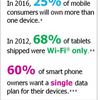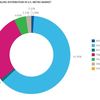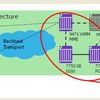By Mae Kowalke, TMCnet Contributor
The move to LTE networks, increasing data usage, and the proliferation of multiple devices per user has ushered in the concept of shared data plans.
Shared data plans offer benefits both to consumers and operators. For carriers, shared data plans mean the ability to have a single pool of data minutes that they can use across their multiple devices. For carriers, shared data plans mean increased customer loyalty and additional revenue opportunities.
However, shared data plans also mean challenges for carrier charging systems.
“One key goal of the system is to track how much of the data quota is still available for use,” noted a recent TechZine posting, Tracking Data Usage in a Multi-Device World, by Pramod Koppol, CTO of the Payment, Policy & Charging business at Alcatel-Lucent. “With shared data plans, the factors involved in tracking the balance can be quite complex.”
Source: Alcatel-Lucent
That’s because smart devices offer always-on data sessions, multiple simultaneous sessions can occur on a single device, and data usage patterns can be highly diverse across users depending on the types of applications and services each prefers.
This challenge can lead to two negative possible outcomes that definitely will not drive customer loyalty.
First, it hinders carrier’s ability to deliver timely and accurate alerts such as notifying subscribers when they have reached a particular threshold in their data usage. Second, a session request could be rejected because the charging system is not aware that data is still available for use.
“Both these issues are most likely to occur when many data sessions are active simultaneously,” noted Koppol.
The way that shared data plans work from a charging perspective is that each session request is allocated a data slice from the overall plan quota. When this slice is used, another slice is issued. When the session ends, what’s left of the slice is added back to the quota. But while a session is using a slice, there is no way for the charging system to know how much of that slice will be used.
Using smaller data slices is one obvious solution, but this adds tremendous extra signaling load. More sophisticated measures are needed.
“In general, a variety of approaches can be used to determine the per session slice size for multiple simultaneous data sessions,” Koppol explained. “For example, slices can be assigned as a portion of the full monthly quota, getting smaller as the month proceeds, but with a minimum and maximum applied. The size can be set according to static attributes, such as device type, access type or Cost of Service (COS) category. Or it can be determined with dynamic attributes, such as location and usage. A combination of these factors can also be used.”
Whatever method is employed, however, it is important for carriers to use a modern charging system such as Alcatel-Lucent’s SurePay solution that can handle advanced shared data plan allocation issues. Because although shared data plans are a boon both for carriers and consumers alike, the billing issues certainly aren’t welcome.













